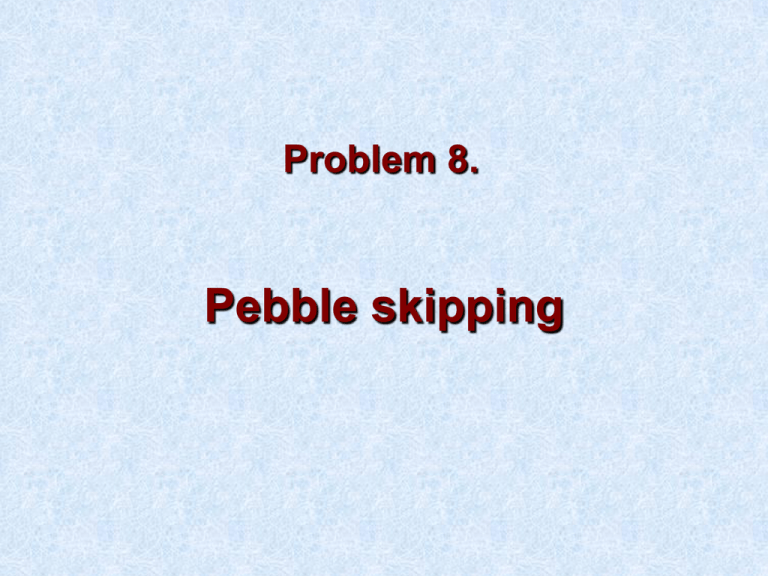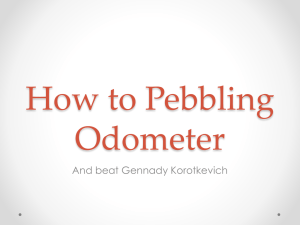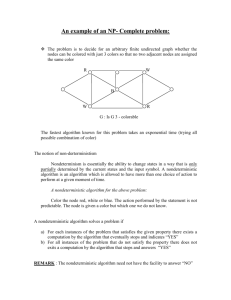Document
advertisement

Problem 8. Pebble skipping Problem It is possible to throw a flat pebble in such a way that it can bounce across a water surface. What conditions must be satisfied for this phenomenon to occur? Basic idea • The conditions needed for a flat pebble to skip on a water surface are: • Initial velocity should be greater than 3 m/s • Angle between water surface and the main plane of the pebble (angle of attack) should be between 10˚ and 30˚ • The pebble has to rotate Experimental approach • Parameters influencing the motion of the pebble on water: • Pebble characteristics (mass, shape, dimensions) • Angle of attack • Velocity • Rotational velocity The experiment was divided in two parts: 1. Throwing pebbles on a water surface (lake) 2. Laboratory measurements 1. Throwing real pebbles • Goals: • Determine the optimal shape, size and mass of a skipping pebble • Find the best way of throwing skipping pebbles 1. Varying the shape and mass of the pebble Mass • A massive pebble needs greater velocity to skip Shape • A flat pebble (big contact surface) will skip best Conclusion • An ideal skipping pebble should be: • Flat • Realtively heavy • With big surface area • The shape isn’t as important; most pebbles found in nature are irregular • Many different, nonideal pebbles will skip too if given an initial velocity large enough 2. Laboratory measurements What to measure? • Lift and drag coefficients with varying • Angle of attack • Pebble velocity • Net hydrodinamical force on pebble • Minimal velocity needed for bouncing Experimental setup Forcemeters Water jet Water jet Pebble • The measurements had been performed with an idealized pebble model Model Results Drag coefficient vs. lift coefficient 0 ,0 1 6 20 0 ,0 1 4 lift co e fficie n t - C l 0 ,0 1 2 30 10 0 ,0 1 0 0 ,0 0 8 20 30 0 ,0 0 6 10 0 ,0 0 4 0 ,0 0 2 20 30 5 10 5 5 0 ,0 0 0 0 ,0 0 0 ,0 2 v = 5 m /s v = 3 m /s v = 8 .8 m /s 0 ,0 4 0 ,0 6 0 ,0 8 d ra g c o e ffic ie n t - C d 0 ,1 0 0 ,1 2 0 ,1 4 0 ,2 5 d ra g c o e ffic ie n t - C d 0 ,2 0 0 ,1 5 0 ,1 0 0 ,0 5 0 ,0 0 0 ,0 2 ,0 e + 4 4 ,0 e + 4 6 ,0 e + 4 8 ,0 e + 4 R e yn o ld s n u m b e r 2 0 ° 1 0 ° 5 ° 3 0 ° 1 ,0 e + 5 1 ,2 e + 5 0 ,1 0 0 ,0 8 lift [N ] 0 ,0 6 0 ,0 4 0 ,0 2 0 ,0 0 0 ,0 0 ,1 0 ,2 0 ,3 0 ,4 0 ,5 0 ,6 0 ,7 d ra g [N ] v v v v = = = = 1 .6 m /s 3 m /s 5 m /s 8 .8 m /s • The red line indicates the skip limit (lift force > gravity) of our model Conclusion • Angle of attack • For our model the optimal throwing angle is about 20° • The minimal throwing angle for pebble velocity 8.8 m/s is 10° • Minimal velocity • The jump limit of our model was at about 3.5 m/s for optimal angle of attack • For other angles the minimal velocity is greater Theoretical approach Forces acting on the pebble during contact • Hydrodinamical forces: Lift Fl 1 2 C l S im w v Cl – lift coefficient 2 Cd – drag coefficient ρw – density of water Drag Fd 1 2 C d S im w v v – pebble velocity 2 Sim – immerged surface of pebble Gravity F g mg m – pebble mass g – free fall acceleration Defining the coordinate system Fu Fo eˆ 2 eˆ 1 v Fl, Fd – lift and drag forces θ – angle of attack v – pebble velocity eˆ1 , eˆ 2 - unit vectors φ – angle between surface and velocity vector Equation of motion • In components: m dv x dt m dv z dt 1 2 t v S u C l sin C d cos mg 2 1 2 w v S im C d cos C l sin 2 vx – x – component of velocity vz – z – component of velocity θ - angle of attack Simplifying the equation of motion v 2 v 2 x0 v 2 z0 v 2 x0 vx0 – x – component of velocity vz0 – z – component of velocity 2 m d z dt 2 mg 1 2 w v x 0 S im z 2 C d cos C l sin • The function S(z) depends on the shape of the pebble • The model will use a circular pebble Circular pebble Su z z Su z Su zr sin r – radius of the pebble z - immerging depth Estimating the minimal velocity - forces • Bouncing condition: mg F mg 1 2 F - mean value of vertical component of hydrodinamical force w S im v 2 S im - mean value of immerged surface • For the estimation we may approximately take S im 1 2 r 2 r – pebble radius v 2 mg r w • For our model (20˚ angle of attack) this limit was 4 m/s which is in good agreement with the experimentally obtained value of about 4 m/s Estimating the minimal velocity - friction • Another bouncing condition can be found using energy: 1 2 mv x 0 W d 2 Wd – work of friction (drag) t coll Wd vx0 F t dt x W tr mg v x 0 t coll 0 tcoll – time of pebble collision with water surface μ - ˝coefficient of friction˝, def. Cd cos Cl sin vv x0 2 g t coll • Collision time is generally of the order of magnitude 10-1 s • That means that the condition for 20˚ angle of attack is v > 3 m/s • This condition is less restrictive than the previous, so we can say that the unique condition is v 2 mg r w Why rotating the pebble? • During the contact of pebble and water surface a destabilizing force occurs: Fu r v dest r – radius vector Ω – angular velocity of precession (changes θ) τdest - destabilizing torque • If the pebble is rotated, the resulting gyroscopic effect will counteract the change of attack angle: r v dest ω – rotational angular velocity Conclusion • The conditions needed for a pebble to skip on a water surface are: • Initial velocity usually greater than 3 m/s • Angle of attack between 10˚ and 30˚ (for our model the optimal angle was 20˚) • Large rotational velocity










